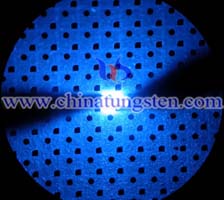Potential Sapphire Substrate Disruptions
- Details
- Category: Tungsten & Sapphire Growth Furnace News
- Published on Wednesday, 19 February 2014 17:58
It is certain that HB-LED manufacturing will ultimately move to large-diameter sapphire substrates. The  question is how quickly, and what material will be used for the substrates? In this last section we’ll briefly look at potential answers to these questions.
question is how quickly, and what material will be used for the substrates? In this last section we’ll briefly look at potential answers to these questions.
As we said at the beginning, adoption of large-diameter is currently low and predicted to take years to complete. However, advances in alternative substrates to traditional sapphire may accelerate this adoption or carve out niche channels for some companies. But first we’ll focus on sapphire.
The main challenges we noted were the low material utilization due to a-axis growth and the high level of defects that make larger wafers expensive. There are alternative growth technologies that can grow directly on the c-axis for much lower waste. In addition, growth technologies that avoid significant defects are also available.
Sapphire grown with these characteristics of c-axis growth (also called on-axis growth for LED applications) and low defect levels are very well optimized for large-diameter applications.Depicting c-axis CHES technology, the problems of low material utilization and high defect levels are both solved at once, with the additional benefit of a near net shape boule. The result is over 75% utilization for both 6- and 8-in applications.
In addition, the problems of warp during epitaxy that we saw from a-axis-grown sapphire are reduced as the c-axis CHES wafers are grown with a single time signature across their surface (Fig. 8). Because of these advantages, it is expected that as more manufacturers move to large-diameter applications, the growth technologies will also transition to c-axis, low-defect-level growth.
Alternative substrates to sapphire, such as silicon, silicon carbide, and gallium nitride (GaN) are also being researched. A small number of LED manufacturers are even in production on each of these substrates, yet not as a cost-effective alternative to sapphire. Each of these alternatives has certain advantages over sapphire, yet multiple breakthroughs are needed for one of them to significantly displace sapphire. Of the alternative substrates, current predictions give silicon the best chance for success.
Because LEDs have such a broad potential market, there will be room for these alternative substrates along with sapphire remaining predominant. For example, an advantage GaN substrate brings is higher performance per chip – albeit at very high cost. This substrate may find a niche where a single bright LED chip is desired or required.
The next diameter past 6-in is the 8-in wafer. These wafers give another dramatic gain in LED chip count and further opportunities for yield improvement. Yet the barriers we examined earlier are the same, with the addition of the sapphire substrate costs doubling over 6-in using a-axis growth methods. Therefore the prediction is that one of these alternative technologies (sapphire grown on c-axis, silicon, or another substrate) will become dominant for 8-in wafers and beyond.
Tungsten Manufacturer & Supplier: Chinatungsten Online - http://www.chinatungsten.com
Tel.: 86 592 5129696; Fax: 86 592 5129797
Email: sales@chinatungsten.com
Tungsten & Molybdenum Information Bank: http://i.chinatungsten.com
Tungsten News & Tungsten Prices, 3G Version: http://3g.chinatungsten.com
Molybdenum News & Molybdenum Price: http://news.molybdenum.com.cn



 sales@chinatungsten.com
sales@chinatungsten.com